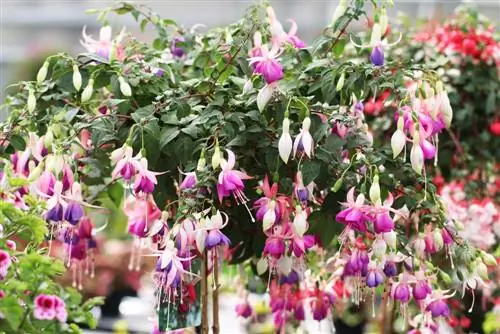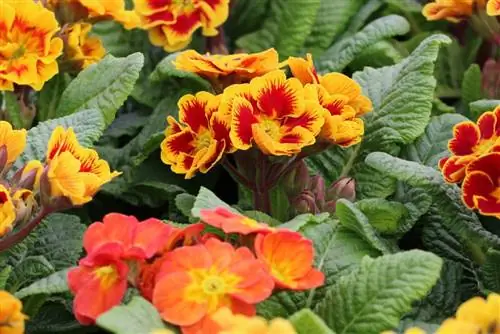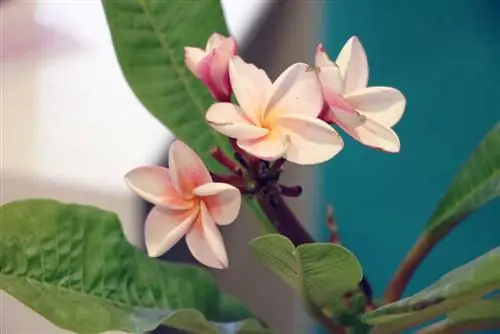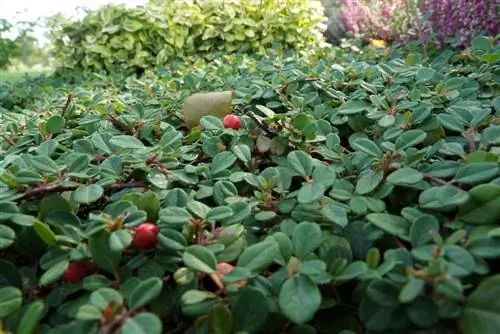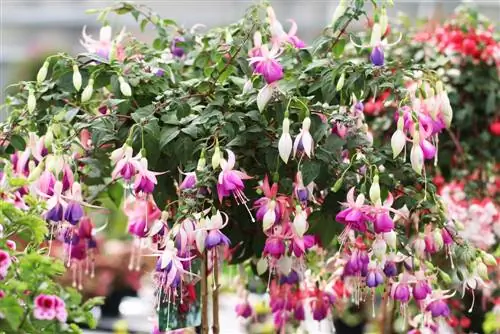- Author admin [email protected].
- Public 2023-12-17 03:39.
- Last modified 2025-01-24 12:45.
Hobby gardeners with balconies also want a colorful variety here. Many flowers and plants are suitable for even the smallest spaces. But of course every flower and every plant needs its own care and the right fertilizer so that it can thrive and grow. Therefore, before planting on a balcony, care should be taken to ensure that the flowers require similar care and fertilization so that the effort for the hobby gardener is not too great.
Balcony plants
A balcony is usually designed very diversely with plants and flowers, even in the smallest space. Blooming flowers often alternate with green plants, herbs, cacti or even small Mediterranean trees such as a lemon or olive tree. But all of these flowers and plants on the balcony are also very different in type and care. Flowering plants need more fertilizer than those that “only” have green leaves. Plants that are supposed to bear fruit also need to be fertilized differently. But all of these flowers and balcony plants have one thing in common: they are cultivated in a pot or bucket and not outdoors like in a garden. It is therefore important, especially for plants grown in pots, to ensure that they are not over-fertilized. In addition to too little fertilizer, too high a dosage can also be harmful. And especially with potted plants, the overdose cannot flow off immediately, as is the case with outdoor plants, where the fertilizer can drain into the soil more quickly with the irrigation water. It is irrelevant whether industrially produced fertilizer, such as slow-release fertilizer, or natural fertilizer, such as compost, is used.
Fertilizer composition
Every plant, whether flowering or not, needs nutrients that are already contained in the ideal composition in the various fertilizers available on the market. These fertilizers can be organic or mineral in nature, solid or liquid. But there are certain main nutrients that should be included in every fertilizer, the so-called complete fertilizer:
- Nitrogen, listed as “N” on the fertilizer package
- Nitrogen ensures lush, green leaves
- Phosphorus, which is marked with “P”, is responsible for fruit formation and flower splendor
- The water balance of plants is regulated by the nutrient potassium “K”
- smaller amounts of boron, manganese or iron are also required for balcony flowers
If you are not sure which fertilizer is right for your balcony plants, you should seek advice from a specialist retailer and use special fertilizers such as those for geraniums, cacti or roses. In this way, the various balcony plants receive exactly the nutrients they need.
Dosage forms
Ideally, long-term fertilizers are used for balcony plants, because in this way only a short time is needed to fertilize the balcony plants; fertilization at the beginning of the season is usually sufficient. In rare cases it needs to be fertilized again in early summer. But even an inexperienced hobby gardener can learn all of this from the manufacturer's information on the various fertilizers. Commercial fertilizers are usually offered in the following dosage forms:
- Liquid fertilizer, is added to the irrigation water in the suggested dosage
- fertilizing with liquid fertilizer may be necessary weekly or monthly, depending on the information
- Fertilizer in solid form, for example beads, which simultaneously improve the soil
- Fertilizer is in solid form and is usually a long-term fertilizer that only needs to be added once at the beginning of the fertilization period
- Fertilizer sticks that are inserted into the soil and from there regularly release the nutrients to the plant
Tip:
Fertilizing with compost is not recommended for balcony plants as it is incorporated underground. With many tubs and pots on a balcony, this means a lot of work. But when planting for the first time, the soil used for the first fertilization can of course be mixed with compost.
Ideal period
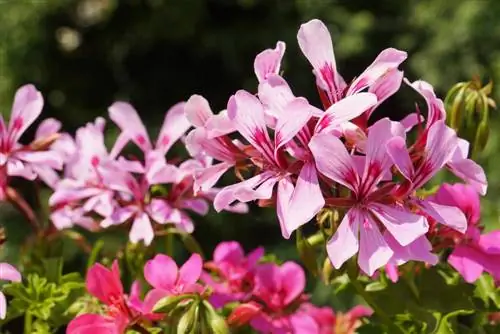
Flowers and plants are usually only fertilized during the growth phase. But here too, every plant is different. Early bloomers therefore need to be fertilized at the end of winter so that they show their flowers in spring; other plants only need fertilizer after the last frost because they are on the back burner beforehand. But there are rules of thumb that apply to all flowers and balcony plants:
- fertilize only during the main growth period of the various plants
- this can be scheduled from the beginning of March to the end of September
- usually stop fertilization after August 15th
- After this point, only use so-called autumn fertilizer for autumn bloomers
- these help the plants overwinter by adding more potassium
Dosage
When dosing the fertilizer for balcony plants, the most important thing is what effect you want to achieve. As a rule, all balcony plants should be fertilized because each type of plant requires a certain amount of nutrients throughout the year. Flowers on the balcony are usually fertilized with fertilizers from specialist retailers, so you can always pay attention to the manufacturer's instructions, so even inexperienced hobby gardeners are on the safe side. Otherwise, you should pay attention to the following when fertilizing:
- especially when using liquid fertilizer, make sure that it is never applied directly to the root ball with the irrigation water
- do not fertilize when the soil is dry
- Even when using liquid fertilizer, prepare the soil for fertilization the day before with irrigation water
- Give flowers some time after repotting so that the roots can regenerate and only fertilize when the next fertilization period is due
- So that the nutrients can reach the roots of the plants, loosen the soil well before fertilizing
- If the rainy season is longer, the added nutrients are washed out more quickly
- If the balcony pots are outdoors without a roof, then fertilization must be carried out more frequently during a rainy period
Tip:
There are now specially formulated fertilizers commercially available for almost every type of plant, including in a wide variety of dosage forms. For example, a liquid fertilizer has to be added more frequently during the fertilizing season. If you like to keep it simple, you can also use special fertilizer sticks.
Conclusion
Everyone who doesn't have a garden wants to have a beautiful, blooming and green balcony with a wide variety of flowers. And caring for such a balcony with its many different types of plants is not that difficult if you use the right fertilizers, such as slow-release fertilizer for the balcony plants. If the hobby gardener follows the manufacturer's instructions, then he can properly fertilize the balcony flowers and enjoy his green and colorful oasis in the middle of the city from early spring until well into autumn.
What you should know about balcony plant fertilizer in brief
There are different types of slow-release fertilizers for balcony plants. The dosage forms are just as different as the composition:
- Granules, which are simply mixed into the soil, are very popular. This is also the cheapest form of long-term fertilizer. The dimensions can be made individually as needed and thus adapted to the amount of soil and the needs of the plant.
- Next, you can purchase slow-release fertilizer in a cone shape. You put this in the potting soil and the fertilizer can release its nutrients.
- The third form is the fertilizer stick, which everyone should be familiar with. Depending on the diameter of the pot, one or more of these are inserted into the ground.
All long-term fertilizers usually work for up to 6 months. Nevertheless, you should always read the package information carefully, also because fertilizers can be harmful to people when used improperly. The application of slow-release fertilizer should be closely linked to the balcony pot plants. Before you use any product, you should understand the needs of the plants. The fertilizer should suit the plant. This is the only way to achieve an optimal result.
- Mainly, slow-release fertilizers result in better growth, lush greenery and good flowering.
- This requires a balanced nutrient ratio. Nitrogen, phosphate and potassium are the basic substances of a fertilizer.
- But there are also fertilizers that contain more of one nutrient and less or none of another.
- The ratio of the individual substances to each other depends on the potted plant and the soil used.
In short:
Long-term fertilizer is ideal for use on balcony plants. Since most of them take effect for around six months, you can cover the entire growth phase with fertilizer in one application. But making the right choice is essential.

